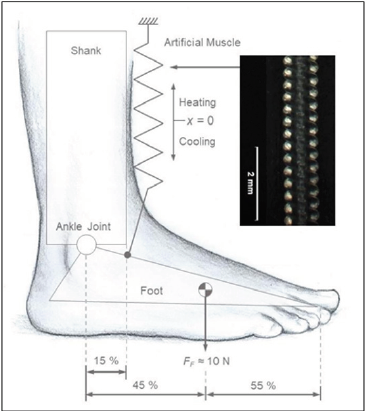Introduction
One of the most important forms of human movement is
walking. The foot-shank-complex with the associated ankle joint
has a central function. Due to numerous neurological and muscular
diseases or injuries, walking can be negatively affected. The care
of people with those impairments is made by orthopedic and
rehabilitation technologies. For example, orthosis are attached to
the ankle joint from the outside. However, commercially available
orthoses often cannot sufficiently help to develop a physiologically
healthy walk. Users are often severely restricted in their mobility.
Out-of-rounds movements lead to further problems with the
musculoskeletal system and another treatment can be necessary.
Furthermore, pressure marks can arise through the orthoses. The
aim of the research project “Aktiv Orthese” is the development
of an active, soft ankle-point-orthosis. For this purpose, a system
is developed which allows a physiologically normal walk. Thus
enables a walk that is biomechanically natural and functional. The
innovative ankle-point-orthosis is intended to support the patient
fully automatically in the walking motion. At the same time it shall
be so light and flexible that it does not disturb or restrict the wearer
when moving. This is to be achieved by the development of a textile
structure that does not require any rigid elements.
(Figure 1) shows the basic idea of the active ankle-pointorthosis.
The essential function is to help lift the patient’s foot and
to prevent uncontrolled fall of the forefoot after heel strike. The
needed actuator in the form of artificial muscles based on polymer
fibers is developed at the Faserinstitut Bremen. The requirement
is that on the one hand it is powerful enough to lift the patient’s
foot while walking; on the other hand it is light and flexible. The
functional principle of the artificial muscles is based on the
material properties of polymer fibers: Highly drawn, partially
crystalline polymer filaments often have a negative coefficient of
thermal expansion in fiber direction. They contract with increasing
temperature. When such filaments are twisted, the effect results
in torsion of the filament. Responsible for thermal contraction
are the molecular structures, which mean crystalline parts of high
orientation. They are spirally located in the filament.
With a helical arrangement of the twisted filament and use of the heat-induced torsion, a shortening of the spiral formed can be realized analogous to a helical spring. The functional principle of the artificial muscles has already been described in numerous publications [1-3]. This article presents the concrete application, the manufacturing and the investigation of the properties. The artificial muscles are manufactured on a specially developed structure. The monofilament material used is Perlon. Different muscle diameters can be generated. The vertically suspended weighted monofilament is twisted by an electric motor. By recording the number of revolutions with a magnetic counter, the length of the muscles can be calculated. By changing the weight, the spring rate of muscle can be determined. After twisting, the artificial muscles are thermo-fixed. On the one hand, thermo mechanical and, on the other, dynamic behavior is of major importance for the application of artificial muscles as an actor in orthoses. The results show the potential of artificial fibers based on twisted polymer fibers for use in an active orthosis. With the experiments performed on the artificial muscles, the strength, the path and the dynamics of the system can be measured and determined.
References
- Haines C S, Lima MD, Li N, Geoffrey M Spinks, Javad Foroughi, et al. (2014) Artificial Muscles from Fishing Line and Sewing Thread. Science 343(6173): 868- 872.
- Moretti G, Cherubini A, Rocco V(2015 ) Experimental characterization of a new class of polymeric-wire coiled transducers.Behavior and Mechanics of Multifunctional Materials and Compositespp. 9432.
- Saharan L, Tadesse Y (2019) Novel twisted and coiled polymer artificial muscles for biomedical and robotics applications. Materials for Biomedical Engineering: Nan biomaterials in Tissue Engineering p. 45-75.

 Mini Review
Mini Review
